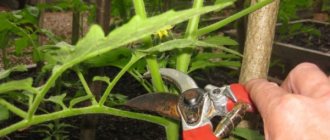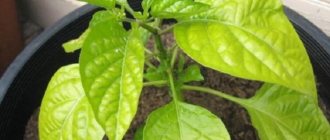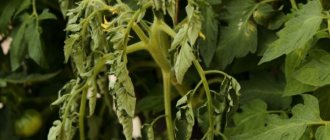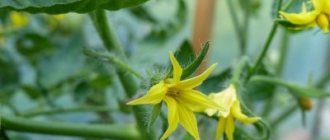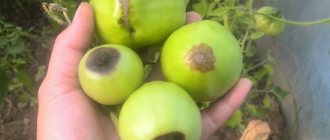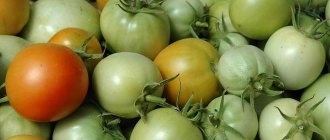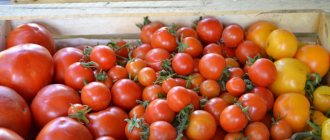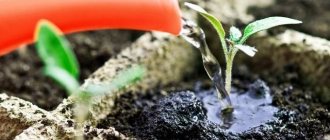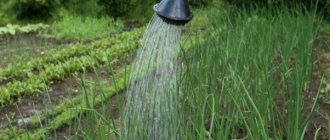An important element in growing tomato seedlings at home is the application of fertilizers. Until now, summer residents often make mistakes when feeding tomato seedlings. But an excess of microelements is just as harmful to any seedlings as an insufficient amount of fertilizer.
Dear readers! For you, we have created communities on social networks in which useful articles and interesting ideas are published several times a day! Subscribe and receive useful content in a convenient format!
Today we’ll talk about how to feed tomatoes correctly. You will learn to determine the time of fertilization, learn how to determine insufficient amounts of microelements, and which store-bought and home remedies are most effective.
When to feed tomato seedlings
There is no need to feed young tomato seedlings too often. The optimal number of fertilizing is 2. In extreme cases, fertilizers are applied a couple more times. But they use gentle drugs, folk remedies and reduce the concentration of active substances.
The first time fertilizer is applied after picking. Moreover, you do not need to feed immediately. They wait 10-15 days and then apply fertilizer. At this stage, Nitroammofoska is used, an affordable and effective drug.
If you immediately sowed the seeds in individual containers, then the first fertilizing is carried out approximately 18 - 22 days after the appearance of the first shoots. At this time, the seedlings should already have at least 2 true leaves.
The second feeding takes place 11 - 16 days after the first procedure. This is an optional supplement. It is carried out if the seedlings did not tolerate picking well. Feel free to mix the same solution. Please note that you should not try to save the fertilizer the first time. It will fall into disrepair. We need to prepare a new remedy.
The third (or second) feeding occurs shortly before planting the seedlings in the garden or greenhouse. Fertilizers should be applied approximately 3-5 days before the procedure. Feed at the rate of 100 ml per 1 seedling. The solution is prepared from 1 spoon of superphosphate, the same amount of ash and 10 liters of warm water.
ON A NOTE. Don't have a lot of seedlings? Reduce the proportions by multiples so as not to pour out the working solution.
General rules of care
- Maintaining temperature conditions. Excessively high and excessively low temperatures are harmful to seedlings. The optimal temperature is +20C – +25C during the day and +18C at night.
Lighting. The duration of daylight hours for seedlings should not be less than in summer. When planting seedlings in February, you must remember that you will have to purchase a special phytolamp. It can provide different light intensities - this is an important condition for growing seedlings at different stages. All the nuances on this issue are outlined in the instructions for the lamp.
- Diving is usually done at the stage of “1-2 true leaves”. The “older” the seedling, the more difficult it will survive this process. Afterwards, the seedlings should not be watered for 5 - 6 days so that the plant can take root.
- “Hardening off” seedlings. 1 - 2 weeks before planting the seedlings in the soil, you need to open the windows for a couple of hours on which the boxes with future tomatoes are placed. Gradually, the “ventilation” time must be increased to 6–8 hours, and after 3–5 days the containers should be taken out into the open air in calm, windless weather.
How to determine that tomato seedlings need feeding
During all the weeks of seedling development at home, they need various feedings at different stages of growth.
The lack of microelements is manifested in the appearance of the plant. The color and structure of the foliage and stem changes, growth slows down, etc. Let's look at the main signs that your seedlings need help.
Table. Signs of micronutrient deficiency in tomato seedlings
| What element is missing? | External sign of deficiency | What to feed |
| Potassium | The appearance of small yellow spots on the leaves. “Burn” edges of sheet plates | Potassium sulfate, potassium monophosphate, potassium magnesium. To mix the solution, you need 1 liter of the active drug per 1 bucket of water. Infusion of crushed wood ash. |
| Nitrogen | Slowing down the development of seedlings. Yellowing of veins on leaf blades. The process spreads from below | Treatment with a solution of ammonia or urea on the sheet. |
| Calcium | Dying of foliage. The new leaves are very small. Presence of stains on leaf plates | Spraying with infusion of calcium nitrate (5 spoons per 5 liters of water). |
| Phosphorus | Redness of the lower part of the leaf blade. Sometimes the leaves stretch upward | Superphosphate, ammophos, phosphate rock. To prepare the working solution, thoroughly mix 2 level teaspoons in 5 liters of warm water. |
| Iron | Leaf chlorosis | Spraying with iron sulfate |
| Other microelements | Change in color of leaf blades of seedlings. Usually observed when transplanting to a garden or greenhouse | Apply complex fertilizer |
When and how often do you need to fertilize seedlings?
You need to fertilize tomato seedlings grown at home not when you have to and as much as you want, but at certain times when the plants especially need nutrients.
It is usually necessary to feed tomato seedlings for the first time when they have 1-4 true leaves. The second time and subsequent ones are fertilized after a few days. The exact timing is usually indicated on the packaging of the drug used for feeding.
What to feed two weeks after germination, when to do the first feeding
Ideally, you should start preparing a working fertilizer solution for the first time only after carrying out a procedure such as diving. It is believed that the soil substrate where the seedlings grow is nutritious enough to feed them until 2-3 leaves form. That is, until the time comes to dive.
But it often happens that just a couple of weeks after germination, seedlings require help. This happens for many reasons: improper care, poor soil, weak seeds, unsuitable room conditions.
Immediately after germination, young seedlings are still too weak. For this reason, the use of mineral complexes is not recommended. It is much better for seedlings if you use gentle folk recipes or bio-based growth stimulants.
- Wood ash. An excellent fertilizer that can be used to feed tomatoes even before picking. Replenishes the deficiency of elements, serves as a prophylaxis against blackleg.
- Root formation stimulator (for example, Kornevin). This type of drug contains many useful substances. Moreover, their concentration is not so high as to harm the seedlings.
- Humate. A slightly diluted solution of humate (Gumi) will allow the seedlings to feel better.
If none of the above is at hand, but you have already purchased mineral fertilizers, then it is permissible to feed the tomatoes with them. However, you definitely need to reduce the concentration of active trace elements. Divide the dose written in the manual by 4 and dilute the solution.
Feeding pepper seedlings
Peppers begin to be fed when the first shoots appear. To begin with, you should give preference to complex fertilizers, which have proven themselves well:
- "Ideal";
- "Effect";
- "Strong."
Fertilizers are applied only at the roots. The second time feeding is done after more than two leaves have appeared on the sprouts. At this time, the ideal solution would be formulations that include:
- ammonium nitrate;
- superphosphate;
- potassium sulfate.
The drug is diluted in water, and then watering measures are carried out. Immediately before planting in the garden, the seedlings are fertilized again. This time it will be enough to add wood ash.
How to feed tomato seedlings after picking
Picking is a big stress for any seedlings. It should be avoided if possible. But most summer residents pick. Therefore, if you carried out the procedure, then the seedlings need to be fed to strengthen their health and help them adapt after transplantation.
No nutrients will be needed immediately after the procedure. Seedlings need several days to “get over” and take root. The time for feeding occurs 1.5 - 2 weeks after the dive.
ON A NOTE. To help seedlings take root in separate containers, they can be watered with a mild solution of Kornevin, Epin, Zircon.
Potassium monophosphate is also quite effective. The solution can be made from Nitroammophoska. It is sold in bags in almost all hardware stores. Proportions: 1 teaspoon per 3-liter jar of water. Consumption rate – 100 ml per 1 seedling.
Scheme for adding nutrients
Young plants vitally need additional nutrients. They should be applied before and after picking and direct replanting in open ground. The procedure is carried out three times, namely:
- The first is carried out before picking; nitrogen-containing and phosphorus-containing complexes are added to the soil. This is done when the third leaf forms on the seedling; on average, this occurs in the third week after sowing the planting material.
- After 15 days, a second feeding is carried out; this period is enough for the vegetable crop to recover. During this time, the plant has already used up some of the elements, so they require an additional dose.
- The seedlings are fertilized for the last time a few days before planting in a permanent place. The nutrients that remain in the earthen coma will contribute to the rapid process of adaptation and rooting.
Note! The time of fertilization is directly related to the quality of the substrate that was used when sowing the seeds. If this is ready-made soil with the necessary complex of substances, then you can refuse the first feeding of tomato and pepper seedlings.
Onion peels will help enrich the soil and disinfect it
What fertilizers can be used at home?
The market for fertilizers developed for seedlings is very wide. Manufacturers offer summer residents a variety of brands to choose from. At their core, many of these drugs are analogues. Let's look at the basic mineral supplements.
How to use superphosphate to feed seedlings
Superphosphate is one of the most commonly used fertilizers. Effective when transferred to the garden and greenhouse. The most popular proportion when preparing a working solution is 3 teaspoons of superphosphate per 10 liters of warm water.
We feed the seedlings with urea
Urea is a fertilizer with a high nitrogen content. You shouldn't get carried away with it often. It is best to apply only if there is a deficiency of the corresponding microelement. The fact is that seedlings become stretched due to excess nitrogen, and in general this element has a negative effect on yield.
Potassium monophosphate
This is a very good fertilizer with the best proportions of components. Potassium monophosphate provokes the growth of seedlings in width, the formation of new shoots and ovaries, and also prevents the seedlings from stretching. In addition, the drug strengthens the general immunity of plants against the effects of fungi, viruses, bacteria and pests.
What should I add to make the stems plump?
How to feed seedlings without chemicals so that the stems are plump? Many beginning gardeners ask a similar question. In addition to all the above methods, experienced agronomists can tell you what other fertilizers provide: seedlings should be fed with iodine every two weeks . 5-6 drops of iodine dissolve in 10 liters of water; the liquid should be added under the roots, avoiding contact with the leaves, no more than once a week. It will be enough to perform one root and one leaf feeding using this method. For foliar feeding, usually mix 1 drop of iodine with 2 liters of warm water and 0.5 cups of whey.
Do not forget about the preparations sold in specialized stores, which are universal: they combine all the mineral elements, nutrients and even organic components necessary for tomato seedlings.
The most popular of them on the domestic market are “Nitrophoska”, “Vermikofe”, “Kristalon”. The method of use and dosage are indicated in the instructions.
We talked in detail about the features of ready-made fertilizers, the pros and cons of using them, in this article.
Folk remedies for tomato seedlings
You can do some of the fertilizing with your own hands using available materials. There is nothing complicated about this procedure. Many homemade recipes are just as effective as store-bought medications. The advantage of folk recipes is that the fertilizers prepared according to them are more gentle in their effect on seedlings.
IMPORTANT TO REMEMBER! Try to prepare small portions of fertilizers so as not to leave them in jars. The fact is that fertilizers created on the basis of organic matter begin to sour and ferment. They become unsuitable for seedlings.
Yeast fertilizer for tomato seedlings
Yeast is a beneficial fungus that stimulates the development of seedlings. The fertilizer is prepared from dry yeast from a 910 g bag), 4 tablespoons of sugar and a bucket of water. It must be stirred in warm water. The concentrate must sit and ferment. It will take about 1-2 days.
Ammonia for tomato seedlings
Ammonia is a source of nitrogen and also a protector against pests. Feeding with this product must be done carefully so that the tomatoes do not begin to fatten. Use it once and only on healthy and strong seedlings.
Hydrogen peroxide for tomato seedlings
Peroxide is an excellent growth stimulant that revitalizes plant tissue and improves metabolism. This product is also good for soil. The third advantage of such feeding is protection from parasites and pathogenic microflora.
How to use ash
Ash or crushed coal is a good potassium and phosphorus supplement. Proportions – 200 g per 10 liters of warm water. The infusion must be kept for 20 – 24 hours. Then don't forget to filter it. In addition to water-based fertilizing, sifted ash can be used to powder seedlings and soil.
How to use iodine
Iodine solutions are used to have a beneficial effect on the overall health of seedlings. The second reason to use this drug is the prevention of fungal diseases.
Fertilizing is done on the leaf, that is, sprayed from a spray bottle. Working solution: 1 drop of iodine per 1 liter of water.
What are the effects of banana peels?
Banana skins are quite effective in fertilizing tomato seedlings. The solution must be infused for 24 hours. Such fertilizer will have a beneficial effect on the health of the seedlings.
But there is no need to be partial with fertilizing. One watering with banana water after the formation of the fourth leaf is enough.
Eggshell
This fertilizer is rich in calcium.
Fertilizer from eggshells is not prepared immediately. It needs time to brew. You will need a 2 liter jar of shells and the same amount of water. It is better to mix everything in a large container. Don't forget, the shell needs to be ground.
Common types
Nettle infusion
To prepare the infusion, you need to collect young nettle leaves. They contain a large concentration of unspent nitrogen, potassium and iron.
- The container is filled 2/3 with nettles and filled with water, but not to the very edge.
- Cover with a lid and leave in a warm place for 7-10 days.
- After the required time 1 liter. The infusion is diluted in 10 liters of water.
- The resulting solution is watered at the roots of tomatoes at the rate of 1-2 liters per plant.
Fertilizing with nettle infusion should not be done frequently . Maximum of two feedings per month.
We invite you to watch a video about it. how to prepare fertilizer for tomatoes from nettles:
Serum
Natural whey can be used for both seedlings and adult plants.
To prepare the solution you need:
- Take 1 liter of dairy product and 20 drops of iodine, mix with 10 liters of water.
- Stir and feed the tomatoes at the rate of 1 liter of product per adult bush.
Ash, iodine, ammonia
To feed tomatoes with ash, you need:
- Dilute 1 cup of ash in 10 liters of water.
- Water the beds with tomatoes with the resulting solution. Simply pour undissolved ash under the plants.
- You can use the ash for foliar feeding. For this:
- 300 grams of ash should be diluted in 3 liters of water and boiled for half an hour.
- After this, let it sit for five hours, increase the volume of liquid to ten liters and add a small amount of liquid soap so that the fertilizer sticks better to the leaves.
- The solution needs to be filtered and sprayed onto the tomato tops.
- With the help of iodine, you can not only speed up the ripening of fruits, but also save tomatoes from late blight. For this:
- Four drops of iodine are dissolved in 10 liters of water.
- The resulting liquid is poured over the tomatoes at the rate of 2 liters per plant.
- Ammonia, being a nitrogenous substance, perfectly promotes the development of plants.
An alcohol solution created with my own hands removes the painful yellowness of the leaves, because when the crop lacks nitrogen, the production of chlorophyll slows down. The universal solution is easy to prepare.For this:
- Mix 50 ml of ammonia with 4 liters of water and water the plant at the root.
For this type of feeding of tomatoes to be as effective as possible, it must be done regularly.
- You can also feed tomatoes with chicken droppings. This fertilizer is fast-acting and contains a lot of nitrogen and phosphorus.
We invite you to watch a video on how to prepare fertilizers for tomatoes from iodine:
We also suggest looking at how to prepare fertilizer for tomatoes from ash:
Video on how to prepare fertilizer for tomatoes from ammonia:
What fertilizers are suitable for tomatoes and peppers at the same time?
These two crops are close relatives, so it is very convenient to use the same fertilizers to save money.
Both vegetables respond well to feeding with yeast, iodine water and banana peel infusion. Like most cultivated plants, these vegetables can be watered and sprayed with growth stimulants (Epin, Kornevin, Krepysh, Athlete, etc.).
Also, potassium monophosphate, nitroammophosphate, superphosphate and urea can be used to feed these crops. But be careful. Fertilizing can be done at the same time if the timing of fertilization is appropriate.
Otherwise, you just buy one package and use fertilizers when needed.
Seedlings, what do you need?
Nitrogen plays a significant role in the formation of the above-ground parts of plants . It is this macronutrient that ensures active growth and the rich green color of the leaves. Enough nitrogen means the seedlings of tomatoes, peppers and other plants look plump, vigorous and strong. But you shouldn’t overfeed either - the plant will begin to fatten, increasing green mass, instead of forming ovaries and producing fruit.
In addition to nitrogen, young plants need a number of other substances: phosphorus, potassium, manganese, iron, boron, copper, zinc, molybdenum, calcium . And, in order not to rack your brains about what specific substance the plants lack, the easiest way is to fertilize them with a complex mineral fertilizer. And the plants themselves will take from the soil what they need. And if you still want to get to the truth, why your plants look this way and not otherwise, a hint sign will help
